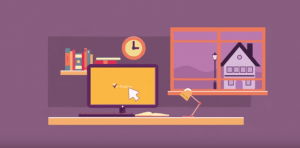
Online education: Other ways of learning, other ways of teaching
04 of August of 2015
Aware of the pros and cons of the online world, we know that this is a developing world, given technological progress, distances, geographic dispersion and the living conditions that exist nowadays.
What is the impact of this situation on education and learning?
What’s the score today….?
Digitalizationis already an unstoppable phenomenon. We live in an increasingly connected world, and organise our daily lives using mobile phones and apps. According to figures from the Fundación Telefónica, one out of every three people checks his/her mobile every five minutes, and social networking is gaining ground among 45-54-year-olds.
The presence of new technologies in society and the opportunities on offer to access and disseminate knowledge means that we are increasingly shifting towards unstable surroundings, towards a world that is increasingly hyper-connected and globalised.
Activities have become much less specific in terms of location and the tasks to be undertaken, with the help of technologies that allow us to work virtually. This means that greater value is given over to the ability to work in changing environments: flexibility, poly-functionality and self-teaching are three such abilities.
And, associated with this context, we see the rise of the modern worker, the so-called “knowmad”: (a hybrid of “know” and “nomad”), who is characterised by being capable of working collaboratively, at any time or place, exchanging information and ideas with other professionals.
A different world calling on new skills to adapt to it and new professionals such as ‘cloud’ Managers, Cyber Lawyers and Digital Artists. According to the McKinsey consulting firm, 60% of the professions required in the years to come will not boast a regulated academic training programme.
And what is the impact of this situation on education and learning?
Other ways of teaching… The “tutor” of the online programme has an important role to play, and nor do I feel that it is different from that of the in-person teacher: that off provoking the learning process. Although I feel that in the online world it is important to provide feed-back, continuous communication and to manage and reinforce relations between people, most of all because this is where one has an advantage over “online” technology… We can use computers to look for information while we, as people, can give over our time, effort and minds to thinking, imagining and making decisions.
And of learning… Now we learn more quickly, we have access to information and we need content flexibility and availability, and for said content to be tailored to our time and location, and not vice versa. We learn from those we trust, and we seek to be increasingly connected, and with greater ease of contact, with people a long way away. Furthermore, we are more familiarised with new online tools (forums, chats, RSS, video-conferencing systems, etc.).
And finally, but no less importantly, it allows for cost savings on the part of both the consumer (Universities such as Harvard, MIT, Berkeley and other prestigious centres of education provide free and online courses and certificates) and to companies, which opt to complement their training courses with this methodology or carry out all their training online (British Telecom and BAE are examples of companies with corporate Universities that only function online).
And that is why we need to have systems that enable us to meet our learning needs, and which mean the strengthening of relations and greater attention paid to the person, in such a way that the pupil, rather than the technology, becomes the centre of the teaching process.
In short, the online system is one of the learning alternatives at our disposal, and can provide the flexibility, accessibility and agility we are looking for.
And to keeping our ear to the ground…?
The world of technology makes great strides… and what we already have and what lies just around the corner in the area of online education includes the following:
- Agile content which adapts itself to the time of the user’s experience. An example of this are videos which “sell the concept” in three minutes. An image is worth a thousand words…
- Resources which make use of game-playing: “gamification”, and which generate interactivity and a certain sense of “competitiveness” in learning. And MOOCs which many of us are already familiar with, continue to grow although their development has seen an increase in drop-out levels – standing at around 80-85% according to figures quoted by MIT in one of its research papers on MOOCs;
- Collaboration, which leads to “informal learning”. The “recommended resource” (we have already heard that we are more trusting of things that reach us through people close to us than from a subject “guru”).
- A change in the way we learn and teach: the personalization of learning, more of a focus on the person, so that the centre of learning is the pupil rather than the technology.
- Wearable technology (watches, wearable gadgets…) is on the rise and undergoing development in the area of learning, beyond mobile phones and/or other electronic devices to keep us informed and to learn in the here and now.
- Big data: data analysis will provide more feedback in order to design more personalised training programmes and to focus on what your public likes and values and, in short, to understand and get to know behaviour patterns in learning.
- Learning on the cloud: there are “cloud school” projects, like learning laboratories, to explore and learn from each other, using resources and tutoring through the cloud.
Ferrovial’s Self Service: E-Academy
Being aware of the advantages and challenges of online education, we are launching our e-Academy, Ferrovial’s online platform, and with the joint work of a project team which will involve all of Ferrovial’s business areas.
What are we looking for with the e-Academy?
To provide Ferrovial employees with a full set of learning and development options, maintaining the values “simplicity” and “closeness”. This is what we say in the launch video.
A way of widening its scope to a greater public: domestic, international, who due to factors of availability and distance, find it less feasible to engage in in-person learning.
We are also seeking to provide a “new way of learning”, more in line with new technologies, and offer “learning multi-resources”: videos, conferences, online courses which will grow progressively. In this area we speak of “self-service” education, which takes shape in a sort of “what do you fancy learning today?” open buffet, available in Spanish and English, and which may help users to learn about various knowledge areas whenever and however they choose (apart from more planned annual and online training).
Furthermore, we saw it as an option to act as a complement to in-person learning in those cases in which it applied. And, obviously, we looked to accompany e-Academy with a communication plan that would express the closeness, simplicity and flexibility of learning that the online methodology allows for.
That is how the e-Academy came into existence – what do you feel like learning today? new times, challenges and ways of teaching and learning.





There are no comments yet